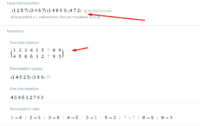First of all I am new in this forum im 20 years old and I am studying mathematics in an university in Greece.
I do not know if i post it at right category but I think it's okey.
I have problem with these 2 exercises and I don't know/understand the steps to find this answers.
1)Find the solution: τ=(1,2,5,7)(3,4,6,7)(1,4,8,9,3)(4,7,2)
answer: (1,7)(2,8,9,4,3,6)(5) => (2,8,9,4,3,6)(1,7)
2)Find the solution:σ=(1,3,5)(2,7)(11,1,4)(5,6,2,8,9)(7,3)(4,5,2,1)
answer: (1,11,3,2,4,6,7,5,8,9)(10) =>(1,11,3,2,4,6,7,5,8,9)
τ,σ are permutations if it was not perceived.
Thank you for your time.
I do not know if i post it at right category but I think it's okey.
I have problem with these 2 exercises and I don't know/understand the steps to find this answers.
1)Find the solution: τ=(1,2,5,7)(3,4,6,7)(1,4,8,9,3)(4,7,2)
answer: (1,7)(2,8,9,4,3,6)(5) => (2,8,9,4,3,6)(1,7)
2)Find the solution:σ=(1,3,5)(2,7)(11,1,4)(5,6,2,8,9)(7,3)(4,5,2,1)
answer: (1,11,3,2,4,6,7,5,8,9)(10) =>(1,11,3,2,4,6,7,5,8,9)
τ,σ are permutations if it was not perceived.
Thank you for your time.


